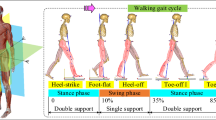Abstract
This paper describes a wearable, master device for people with a spinal injury who can move their neck and shoulders but cannot move their legs and arms. A device that measures the movements of their neck or shoulder can help them to drive a wheelchair. The sensors of such a wearable master device must be lightweight, small, and easily attached to cloth. Therefore, optical fiber curvature sensors are used to measure the human body motion. For a previously developed wearable master device, two calibration and mapping methods with, the sensors are proposed to extract 2-DOF human shoulder motions. One is constructed with simple geometric equations. The other is constructed with a multilayered artificial neural network. The two methods are compared. Experimental results show that the wearable master device can be used effectively for a 2-DOF input device for handicapped persons. It was also shown that a subject can control a mobile robot with the wearable master device.
Similar content being viewed by others
References
Song W-K, Lee H-Y, Kim J-S et al. (1998) KARES: intelligent rehabilitation robotic system for the disabled and the elderly. Engineering in Medicine and Biology Society, 1998. Proceedings of the 20th Annual International Conference of the IEEE, 1998, vol. 5, pp. 2682–2685.
Rosier JC, van Woerden JA, van der Kolk LW, et al., (1991) Rehabilitation robotics: the MANUS concept. 5th International Conference on Advanced Robotics, 1991. Robots in Unstructured Environments, vol. 1, pp. 893–898.
Halley P Les systemes a fibres optiques. Editions Eyrolles
Louis V, Le-Huy P, Andre JM, et al. (1993) Optical fiber-based sensor for angular measurement in rehabilitation. Systems, Man and Cybernetics, 1993, International Conference on Systems Engineering in the Service of Humans, vol. 1, pp. 153–157
Djordjevich A, He YZ (1999) Thin structure deflection measurement. IEEE Trans Instrum Measure 48:705–710
Hagiwara M (1992) Theoretical derivation of momentum term in back-propagation. International Joint Conference, on Neural Networks, Baltimore, vol. 1, pp 682–686.
Author information
Authors and Affiliations
Corresponding author
About this article
Cite this article
Lee, K., Kwon, DS. Wearable master device for spinal injured persons as a control device for motorized wheelchairs. Artif Life Robotics 4, 182–187 (2000). https://doi.org/10.1007/BF02481172
Received:
Accepted:
Issue Date:
DOI: https://doi.org/10.1007/BF02481172




